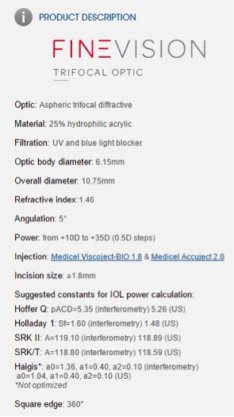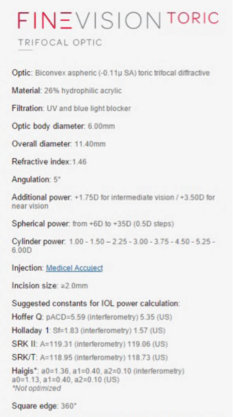This year in Colombia, we gained access to two versions of the FineVision trifocal IOL (PhysIOL): the FineVision Micro F (Figure 1) and the FineVision Toric POD FT (Figure 2). In Europe, where these lenses have been available since 2008, surgeons have reported excellent experiences and visual results, encouraging me to begin offering these IOLs to my cataract and refractive surgery patients.
The FineVision Optic
The FineVision optic combines two diffractive structures that are adjusted to offer the +3.50 D addition for near vision and +1.75 D addition for intermediate vision. It is designed to reduce the loss of light energy resulting from any diffractive system. This energy gain results in a significantly improved performance for intermediate vision while maintaining the performance for far and near vision.
The FineVision optic has a diffractive anterior surface that is entirely convoluted. By varying the height of the diffractive step, the amount of light distributed to the near, intermediate, and distant foci is adjusted according to the pupil aperture.1

Figure 1.The FineVision Micro F product description.
The Micro F and Toric Pod TF
The FineVision Micro F can be used to correct myopia, hyperopia, and presbyopia. The FineVision Toric POD FT can be used for all three of these conditions as well as astigmatism, so this IOL can be used to correct all refractive errors in their vast majority.
For use with the FineVision Toric POD FT, PhysIOL provides a user-friendly calculator that is available in an online version and a downloadable version. The downloadable calculator enables the user to store and access historical data.2

Figure 2.The FineVision Toric POD FT product description.
Trifocal VS Bifocal
Nuijts et al3 compared visual outcomes in patients undergoing cataract surgery and bilateral implantation of a trifocal or bifocal IOL. The trifocal group showed a more continuous defocus curve and better results at -1.00 D of defocus (P<.01). The mean mesopic contrast sensitivity was higher in the bifocal group (P<.02). Complete spectacle independence was reported by 80% of trifocal patients and 50% of bifocal patients. There were no significant differences in refractive outcomes, reading speed, or patient satisfaction. This study showed noninferiority of visual outcomes with the trifocal IOL compared with the bifocal IOL, although the defocus curve was better at an intermediate distance with the trifocal IOL.3
My Experience
I recommend the FineVision trifocal IOLs for patients seeking spectacle independence with or without cataracts and who are aged greater than 50 years and have healthy eyes. Preliminary examination is the same as for premium IOL cases. For my lens calculations, I use the IOLMaster (Carl Zeiss Meditec) and choose a measurement close to emmetropia with the Haigis formula. If the patient has more than 1.00 D of astigmatism, I use the toric design.
These lenses can be implanted using standard phacoemulsification or femto-phaco. A small principal incision can be used, as the FineVision trifocal IOLs can pass through 1.8 mm. Insertion of these lenses has proven to be easy, and the centration in the capsular bag with a 5.5-mm capsulorhexis is also precise.
Conclusion
I have found that patients implanted with the FineVision trifocal IOL designs experience that “wow” effect on postoperative day 1, making them my lenses of choice for cataract and refractive surgery.
1. PhysIOL. Available at:https://www.physiol.eu/en/multifocal-iol/finevision. Accessed December 8, 2015.
2. PhysIOL. Available at: https://www.physiol.eu/en/multifocal-iol/finevision-toric. Accessed December 8, 2015.
3. Jonker SMR, Bauer NJC, Nuijts RMMA. Comparison of a trifocal intraocular lens with a D3.0 D bifocal IOL: results of a prospective randomized clinical trial. J Cataract Refract Surg. 2015;41:1631-1640.





